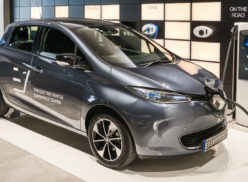By Zubeyde Oysul
Most fears around Europe’s energy crisis have dissipated thanks to a warm winter and emergency measures adopted by the European Union (EU) and its members. EU countries seem to have some breathing room as they implement their ambitious plan to speed up the deployment of renewables and zero-emission vehicles. At the same time, the EU Commission is planning to propose a Net-Zero Industry Act—a European version of the Inflation Reduction Act that aims to build domestic industrial capacity for the advanced energy technologies the EU plans to deploy at a greater scale. Achieving this ambitious goal, however, will require policymakers to also consider—and take action to address—the impact the industrial production of lower-carbon energy and transportation systems will have on the EU’s energy and electricity demand.
Critical minerals are the building blocks of advanced energy technologies. North American and European countries are competing with China to secure access to these minerals and onshore crucial elements of their production and processing. But no country can confront China alone. Success requires like-minded countries to work together and, with other allies and partners, to diversify production and build resilient supply chains.
This is exactly what the United States, European Union, Australia, Canada, Japan, and other strategic partners were doing at the beginning of last year. Then, Russia’s invasion of Ukraine almost one year ago sent an already tight energy market into turmoil. The resulting price spikes and supply shortages threatened the viability of the energy-dependent industrial sector, including Europe’s ability to produce the green products and technologies needed for our shared electrified future.
Nothing is more important to this transition than our ability to manufacture and deploy electric vehicles (EVs). However, an EV requires six times more minerals than a conventional internal combustion engine (ICE) vehicle. Its battery requires lithium, nickel, cobalt, manganese, and graphite; and its electric motor requires rare earth elements. These same materials are also used in advanced electronics, stationary energy storage, and to generate electricity from wind power. Critical minerals have significant defense applications as well. Precision-guided munitions, for example, contain permanent magnets made from rare earth elements.
The processing of minerals and metals today is highly concentrated in China or with Chinese-owned companies, which process anywhere from 50 to 100 percent of all EV minerals. This concentration creates a significant bottleneck, jeopardizing our ability to secure access to the minerals that are vital for our economy and national security.
Countries are starting to take action to reduce the over-concentration of mineral processing. In addition to establishing a $3 billion grant program for the processing of critical minerals, the Inflation Reduction Act (IRA) created a 10% tax credit for the production of critical minerals in the United States. The level of support provided by the IRA has led to some tensions with U.S. partners. It remains to be seen how the Net-Zero Industry Act referenced earlier will tackle this particular part of the critical mineral supply chain.
Unilateral efforts, however, need not be at odds. Diversifying critical minerals supply chains and competing with non-market actors requires a tremendous level of investment and a suite of coordinated well-designed policies. European countries are well positioned to become significant partners with the United States in its effort to end Beijing’s dominance over the critical mineral supply chain. The European Union is already the second largest refiner and processor of cobalt, manganese, and nickel (after China), which provides an opening for technologically advanced democracies to develop more secure and sustainable EV supply chains – if they choose to take it.
A major challenge is that the production of critical minerals is itself highly energy intensive. The mining industry, from extraction to processing, accounts for about a third of global industrial energy use, and 15 percent of global electricity use. Our ability to maintain existing capacity and build new production capacity of cleaner energy alternatives will depend on the availability of cheap and reliable energy sources. New European LNG terminals are not expected to come online until 2025, meaning that energy prices will likely remain volatile for another two years.
To generate this added capacity – and fuel the production of critical minerals and other materials and components needed for the energy transition – the EU countries must do more than simply replace Russian natural gas with gas from other sources. As the EU creates a demand signal to stimulate investment in more green energy technologies and, in particular, new investments in minerals processing, governments must plan collectively to ramp up energy consumption to provide the demand signal to attract private investment to this crucial sector.
The European Union, United States, and their allies do not have time to waste. The market share of electric vehicles is rising rapidly, and with it, the demand for minerals essential to EV batteries and the infrastructure to charge them. By 2030, renewable energy is expected to surpass natural gas to become the predominant source of electricity generation in the United States. The European Union aims to generate nearly half of all of its electricity from renewables by 2030. So there is a narrow window to take advantage of the opportunity to shape the future of critical mineral supply chains by stimulating additional investment in production capacity. Failure to take action now will only take us from one problematic energy dependency to another.
Zubeyde Oysul is a senior policy analyst with SAFE’s Ambassador Hoffman Center for Critical Minerals Strategy.







